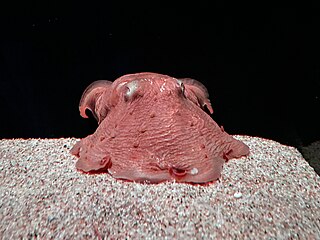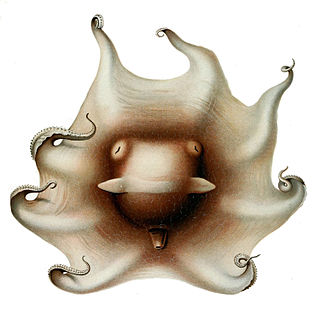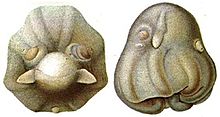
Grimpoteuthis is a genus of pelagic cirrate (finned) octopods known as the dumbo octopuses. The name "dumbo" originates from their resemblance to the title character of Disney's 1941 film Dumbo, having two prominent ear-like fins which extend from the mantle above each eye. There are 17 species recognized in the genus. Prey include crustaceans, bivalves, worms and copepods. The average life span of various Grimpoteuthis species is 3–5 years.

Umbrella octopuses are a group of pelagic octopuses. Umbrella octopuses are characterized by a web of skin between the arms, causing them to somewhat resemble an opened umbrella when the arms are spread.

Opisthoteuthis is a genus of cirrate octopuses, sometimes known as flapjack octopuses, which are found in all the world's oceans.
Grimpoteuthis challengeri is a species of large octopus living in the abyssal zone.

Opisthoteuthis chathamensis, commonly known as the roughy umbrella octopus, is a species of cirrate octopus restricted to demersal habitats surrounding the Chatham Rise in New Zealand. It is commonly known as the roughy umbrella octopus.
Opisthoteuthis calypso or calypso flapjack octopus is a species of genus Opisthoteuthis, which are known as the cirrate octopuses. Octopuses in this genus are known as the flapjack octopuses and can be found in a variety of oceans across the world.

Opisthoteuthis agassizii is a lesser-known, deep-sea octopus first described in 1883 by Addison E. Verrill.
Opisthoteuthis albatrossi is a cirrate octopus originally found off Kinkasan in Japan. This species was described from only four specimens. It is similar to Opisthoteuthis californiana; the two may be the same species. It is also similar to Opisthoteuthis japonica.
Opisthoteuthis borealis is a lesser-known species of octopus found near Greenland and Iceland, especially in the Davis Strait. The species was described from 9 specimens, and is one of the most recent Opisthoteuthis species described. Not much is known about it besides its anatomy and habitat.
Opisthoteuthis bruuni is a species of finned cirrate octopus found along the western coast of South America. Their tissue is almost jelly-like, and they have short, round bodies.

Opisthoteuthis depressa, also known as the Japanese flapjack octopus, is an octopus found in waters near Japan.
Opisthoteuthis dongshaensis is a species of octopus located in the South China Sea.

Opisthoteuthis extensa is a species of octopus found off the west coast of Sumatra, an Indonesian island. It lives at a recorded depth of 768 m (2,520 ft). O. extensa lives in a benthic habitat, like many other cirrate octopuses. It occupies a deep part of the ocean where little sunlight penetrates.

Opisthoteuthis grimaldii is an octopus found near the Azores.
Opisthoteuths hardyi is a lesser-known octopus species. It was described in 2002 from a male caught off the Shag Rocks, which are far south in the Atlantic Ocean near the Falkland Islands.
Opisthoteuthis massyae is an octopus living in the eastern Atlantic Ocean.
Opisthoteuthis persephone is a cirrate octopus living south of Australia. In particular, it lives in waters off Tasmania, Victoria, New South Wales, and South Australia. The octopus has been found 270–540 m (885.8–1,771.7 ft) deep. It lives near and directly above the seafloor. S. Stillman Berry was the first to scientifically describe this species after capturing eight specimens while aboard the F.I.S. Endeavour in the early 1910s. In describing O. persephone, Berry called it an "exceedingly interesting octopod".
Opisthoteuthis philipii is an octopus of the Indian Ocean. It lives off the coast of Kerala, India. Known specimens were found between 275–365 m (902–1,198 ft) deep in the Arabian Sea near Alappuzha.
Opisthoteuthis pluto is a deep-sea cirrate octopus found in the Great Australian Bight south of Australia. They live 270–810 m (890–2,660 ft) below the surface in the bathyal zone. Although their habitat is threatened, it is unclear how the species is affected, if at all. O. pluto is named for the Greek and Roman god of the Underworld.
Opisthoteuthis robsoni, also known as the deep-water umbrella octopus, is a deep-sea octopus living off New Zealand on the Chatham Rise. It has been found from 1,178–1,723 m (3,865–5,653 ft) below the surface. Not much is known about the octopus' habitat or life cycle, as only four specimens have been found. It occupies the benthic zone, or the seafloor and the water directly above it. O. robsoni eats large amphipods.








